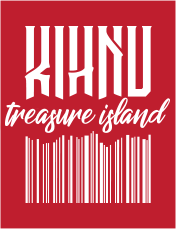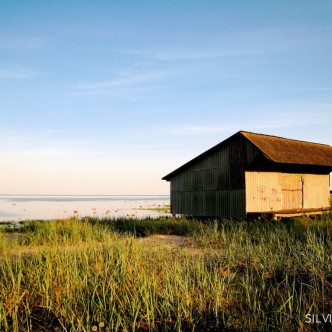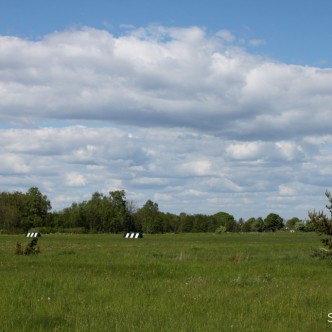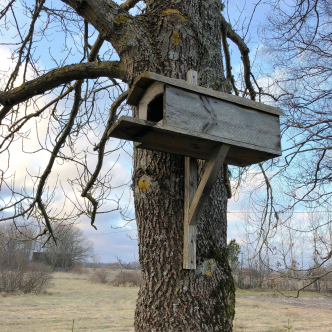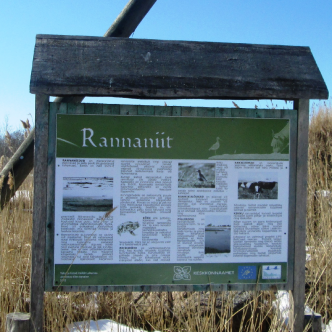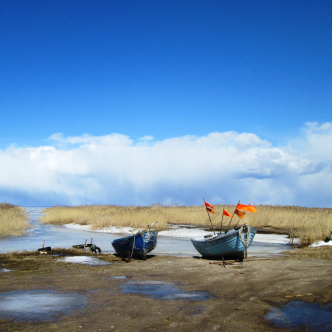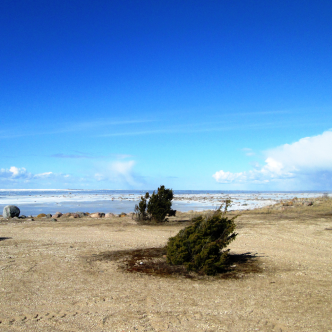Kihnu nature
This small piece of land is extremely connected to the sea – the nature of Kihnu is designed, decided and determined by it. This is reflected in an attractive coast and numerous islets that are homes to nesting birds. But the sea also affects everything that lives and grows on the land: trees, plants, landscape, and animals. Naturally, people are also dependent on the sea and the nature designed by it.
The best way to explore the small island of Kihnu and its nature as well as to see, hear, feel and smell all that it has to offer is with a bike.
Islets – paradise for birds
The shallow and rocky coastal sea is surrounded by reefs and islets. There are 56 islets altogether, eight of them are bigger and there you can go without getting your toes wet, even on high tides. Kihnu Strait is an internationally important nesting, moulting and migration area and this is why all the islets have been taken under nature protection and you cannot go there during nesting season (from April until the middle of July).
The answer to the question how many birds are there in Kihnu is simple: The sky is full of them. But if to be more precise, in 2017 the Environment Agency counted a record number of nesting birds on the islets of Kihnu: only in Imutlaid, there were 4,300 pairs of birds – altogether, 24 different species, mainly terns and gulls. The colony of the Caspian tern that has made itself at home on the islet of Sangelaid, is a real rarity. Every summer, there are two-three Sandwich tern colonies with up to half a thousand pairs – such a high number is also exceptional. The invasion of cormorants is intensively growing. In 2017, 2,906 cormorant nests were counted on the three bigger islets. Kihnu is the place where bird-watching records for the most Eurasian Sparrowhawks and siskins seen in a single day have been set.
The symbiosis of man and the merganser
If someone visits Kihnu for the first time, they might wonder why there are doghouses on trees, as the local dogs do not actually climb trees. These are actually birdhouses, more specifically, man-made nesting boxes built for the most important bird in Kihnu tradition – the merganser (a half-domesticated water bird). The merganser can be considered as a theme bird of Kihnu. Kihnu people and mergansers have developed a silent agreement: man will build a living place for the bird and receive eggs in return. It is important to make clear that by picking the eggs, the number of birds does not decrease; on the contrary, if all the eggs are left in the nest, the mother bird would not be able to incubate them all. Locals know that a good number of eggs in the nest is 10–15 eggs. Then the mother bird will be able to incubate all sons.
The human care does not end there. The merganser family’s journey to the sea can also be long and dangerous: crows, gulls, and cats are quick to take the catch. Even today, you can see Kihnu women taking merganser sons to the sea or Kihnu men securing the bird family’s journey.
Cows are working on coastal meadows
Coastal meadows were close to being forgotten completely in Kihnu because there are no more animals kept in farmhouses – but coastal cows are now eagerly working on the coast. Highland and Hereford cattle are taking care of the coastal pastures; sheep are also helping on the areas with sparser reed. There are about 150 cows and over 300 sheep in the eager work collective. The animals have a lot of work to do because the coastal meadows have developed considerable reed overgrowth.
There are also pastures full of junipers, especially in the southern and western coast.
Pine forest – a powerful sight
Even though it might seem that the island is full of forests, firewood is brought from the mainland and only maintenance logging is done in the forest. Pine is the tree of Kihnu but a big part of local heath pine forests have been planted; at the end of the 17th century, only 2–3% of the island was covered with forests.
The northern part of the island consists mainly of pine forests, the southern side of mixed forests. Spruce is a rarity on the island and those few trees have also been planted by humans.
In addition to the need to get everyday wood, trees were planted to fix dune sand. Humus will also form under the forest, which provides a good growing ground for vegetation. Unfortunately, today we cannot say that Kihnu forests are so clean that there are not even branches on the ground. A majority of the forests belong to the State Forest Management Centre, who does not allow cleaning the broken branches to create a mould layer and soil more full of humus. Nevertheless, you can still see women raking the forests and picking cones. When cleaning up the forests they are also collecting firewood for themselves.
There are a lot of dry sandy pine forests in Kihnu – it is a powerful sight.
Beaches
The three best swimming places in Kihnu are the beautiful sandy beach in Rock City, low and rocky Linaküla beach and the beach strip near the lighthouse. It is possible to swim in all of them but you have to be patient and have the will to walk far enough for the water to get deeper. However, the low coastal water is nice and warm and perfect for swimming.
Kakra säär
If you walk forward from the Rock City beach, the road will lead to a beautiful place, which is called the tip of Pill and that is where the 4 km long Kakra säär begins. The legend has it that Kihnu and Tõstamaa men decided to jointly build a bridge there. The men from Kihnu started with the work but when they saw that the mainland men were slacking, Kihnu men also stopped working.
Animals
Foxes, raccoon dogs, rabbits, and weasels are the terrestrial animals that can be found in Kihnu. The number of hedgehogs has decreased lately. The reason for that is the abundance of foxes and diseases spreading among hedgehogs. Since mainland is not far, wild boars or elks might sometimes swim or in winter time walk to the island over the frozen water. If an elk does wonder to the island, then it will, of course, become instantly famous as such a big animal is an important figure on the island.
Plants
In the spring, you can see orchids on coastal meadows and on the side of roads as the limey soil of Kihnu is a suitable habitat for orchids. It is, however, not allowed to pick these flowers. One of the rarest species that can be found in Kihnu sand dunes is the sea holly, which is a rear coastal plant that has survived in Estonia from earlier climatic conditions dating back thousands of years. Kihnu has the biggest growth places of this protected plant in Estonia, if elsewhere the plant grows individually, then in Kihnu it grows in shrubs. There are altogether 6.2 thousand individual plantss in four growing places.
This attractive sea holly should not be mixed up with sea kale. There is so much of the latter growing on the Kihnu coast that in early spring, it decorates the beach with its white flowers. Because of its maritime climate, spring arrives to Kihnu a few weeks later than to the mainland but, springtime in Kihnu is something else. In early spring, you can see either blue or gleaming forest grounds depending on whether it is the blooming period of the hepatica or the anemone. While spring is picking up speed, the sense of smell is also switched on – Kihnu is drowning in lilacs and smells intoxicating, and the same happens during the blooming period of the lily of the valley.
If you buy primula tea from the pharmacy, the flowers have probably been picked by Kihnu women but there are still enough primulas to decorate the Kihnu meadows with yellow. There are many herbs on the island and a lot of them also make it to the pharmacy.
